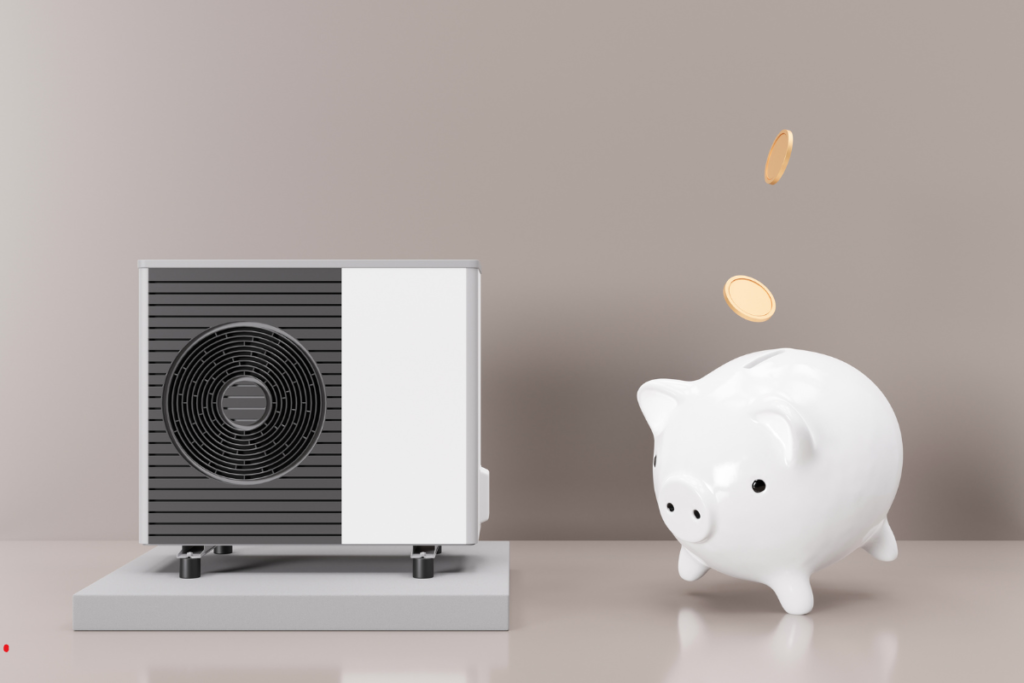What Type of Heat Pumps are Most Efficient?
Heat pumps are advanced technological devices that utilize renewable energy for efficient heating and cooling of buildings. This article will provide a detailed examination of different types of heat pumps, comparing their efficiency, installation, and operational costs, as well as their applications in various climatic conditions. The key question we aim to answer is: “What type of heat pump is most efficient?”
Types of Heat Pumps
Air-to-Air Heat Pumps
Air-to-air heat pumps (ASHP) use outside air as a heat source. Their operation involves a heat exchanger, compressor, condenser, and expansion valve. The main advantages of ASHP are their low installation cost and ease of installation. However, the efficiency of ASHP decreases significantly at very low temperatures, which might necessitate an additional heat source in extreme weather conditions.

Photo: https://energy.nl/data/air-source-heat-pump-ashp-households/
Working Principle
ASHPs operate by transferring heat from the outside air into the building. External air is passed through a heat exchanger where it transfers thermal energy. The refrigerant in the system is compressed, raising its temperature, and then it releases heat inside the building. The expansion valve then lowers the refrigerant pressure, allowing the cycle to repeat.
Pros and Cons
Pros:
- Low installation cost
- Easy to install and maintain
- Suitable for retrofitting existing buildings
Cons:
- Reduced efficiency at low temperatures
- May require an additional heat source in extreme climates
- Air-to-Water Heat Pumps
Air-to-water heat pumps (AWHP) transfer heat from the air to a water-based system within the building. They are often used in central heating systems and for domestic hot water. Compared to ASHP, AWHPs have a higher coefficient of performance (COP), especially in moderate climates. Installation requires a suitable heat distribution system, such as underfloor heating or radiators.
Working Principle
AWHPs work similarly to ASHPs, but the heat is transferred to water in the heating system. The heated water is then circulated throughout the building, providing efficient heating and domestic hot water.
Pros and Cons
Pros:
- Higher efficiency than ASHPs in moderate climates
- Can be used for domestic hot water heating
Cons:
- Higher installation costs than ASHPs
- Requires an appropriate heat distribution system
Ground Source Heat Pumps
Ground source heat pumps (GSHP), also known as geothermal heat pumps, utilize the stable temperature of the ground as a heat source. The system consists of a ground collector (horizontal or vertical), a heat pump, and a heat distribution system. GSHPs are highly efficient throughout the year because the ground temperature is relatively constant. However, installation is costly and requires a large area, but they provide long-term energy savings.

Photo: https://www.consolidatedelectric.com/ground-source-heat-pumps
Working Principle
GSHPs use heat exchangers buried in the ground to absorb heat. The ground collector can be installed horizontally (at shallow depths) or vertically (in deep boreholes). Heat from the ground is transferred to the refrigerant, which is then compressed, raising its temperature. This high-temperature heat is then transferred to the building’s heating system.
Pros and Cons
Pros:
- High energy efficiency
- Stable performance throughout the year
- Low operating costs
Cons:
- High installation costs (typically ranging from €7,000 to €12,000)
- Requires a large area and specialized equipment
Water-to-Water Heat Pumps
Water-to-water heat pumps (WSHP) extract heat from groundwater or surface water sources such as lakes or rivers. WSHP systems are extremely efficient due to the relatively constant temperature of water throughout the year. However, the installation is complex and requires access to a suitable water source, which can limit their application in some locations.
Working Principle
WSHPs draw water from natural sources such as wells, lakes, or rivers. As the water passes through a heat exchanger, it transfers heat to the refrigerant. The compressor then raises the refrigerant’s temperature, and this heat is transferred to the building’s heating system. After extracting the heat, the system returns the water to its source.
Pros and Cons
Pros:
- Very high energy efficiency
- Stable performance regardless of weather conditions
Cons:
- High installation costs (typically ranging from €10,000 to €15,000)
- Requires access to a suitable water source
- Complex installation
Comparing Efficiency
Efficiency Metrics
We measure heat pump efficiency using the coefficient of performance (COP) and the seasonal energy efficiency ratio (SEER). The efficiency ratio of heat delivered to energy consumed is measured by COP, while SEER evaluates performance over a whole heating or cooling season.
COP (Coefficient of Performance)
COP is a key efficiency metric for heat pumps. The higher the COP, the more heat the pump delivers relative to the electrical energy consumed. For example, if the COP is 4, the heat pump delivers 4 units of heat for every unit of electrical energy consumed.
SEER (Seasonal Energy Efficiency Ratio)
SEER measures the efficiency of a cooling system over the cooling season. A higher SEER indicates greater energy efficiency during the summer. For heat pumps used year-round, SEER is important for assessing cooling performance.
Air Source vs. Ground Source
Ground source heat pumps generally have a higher COP than air source heat pumps, particularly in cold climates. For instance, ASHPs can achieve a COP in the range of 2-3, while GSHPs can achieve a COP above 4, indicating greater energy efficiency.
Efficiency in Different Climates
Air Source Heat Pumps:
- In moderate climates, ASHPs can be very efficient, with COPs ranging from 2.5 to 3.5.
- In cold climates, the efficiency of ASHPs decreases, potentially requiring an auxiliary heat source.
Ground Source Heat Pumps:
- GSHPs have a stable COP above 4, regardless of external conditions.
- GSHP efficiency is not affected by air temperature, making them ideal for extreme climates.
Installation and Operational Costs
The installation costs of air source heat pumps (ASHP, AWHP) are lower than ground source (GSHP) and water source heat pumps (WSHP). Operational costs depend on local climatic conditions. Ground source heat pumps have higher initial costs but offer lower operating costs and longer system lifespan.
Installation Costs
Air Source Heat Pumps:
- Low installation costs, typically ranging from €2,000 to €3,500.
- Quick and easy installation, often possible within a few days.
Ground Source Heat Pumps:
- High installation costs, ranging from €7,000 to €12,000 or more.
- Installation requires groundworks, which can take several weeks.
Water Source Heat Pumps:
- Installation costs depend on the availability and quality of the water source.
- May require specialized studies and permits, increasing costs.
Operational Costs
Air Source Heat Pumps:
- Higher operational costs in cold climates due to reduced efficiency.
- May need an auxiliary heat source, increasing operational expenses.
Ground Source Heat Pumps:
- Low operational costs due to stable efficiency and high COP.
- Long system lifespan, reducing long-term costs.
Water Source Heat Pumps:
- Very low operational costs with a suitable water source.
- Require regular maintenance and monitoring of water quality.
The Most Efficient Heat Pumps
Geothermal Heat Pumps
People consider geothermal heat pumps (GSHP) the most efficient due to the stable ground temperature. GSHPs offer the highest coefficient of performance and deliver consistent heating and cooling throughout the year, regardless of external weather conditions. Although installation costs are high, the long-term energy savings and low operational costs make them a cost-effective choice.

Photo: https://www.energy.gov/eere/geothermal/geothermal-heat-pumps
Working Principle
GSHPs use heat exchangers buried in the ground to absorb heat. You can install the ground collector either horizontally (at shallow depths) or vertically (in deep boreholes). The system transfers heat from the ground to the refrigerant, which is then compressed to raise its temperature. This high-temperature heat then moves to the building’s heating system.
Efficiency and Costs
- High efficiency (COP > 4)
- Stable performance throughout the year
- High installation costs (typically €7,000 to €12,000)
- Low operational costs
- Long system lifespan
Hybrid Technologies
Modern hybrid systems combine various technologies, such as air-to-water heat pumps with solar panels, to increase efficiency and energy independence. Hybrid systems can optimize energy use, reducing operational costs and increasing the overall system efficiency. However, the installation of such systems is more complex and requires careful design and integration of different energy sources.
Working Principle
Hybrid systems combine different energy sources to maximize efficiency. For example, solar panels can supplement an air-to-water heat pump, providing additional energy on sunny days. This approach achieves higher efficiency and energy independence.
Pros and Cons
Pros:
- Higher energy efficiency
- Reduced operational costs
- Greater energy independence
Cons:
- Higher installation costs (typically starting from €4,000)
- Complexity of the system and need for precise design
Conclusion
Choosing the most efficient heat pump depends on several factors, such as location, climate, available space, and budget. Ground source heat pumps (GSHP) are the most energy-efficient but have high installation costs and require ample space. Air source heat pumps (ASHP, AWHP) are less expensive to install but may be less efficient in extremely cold climates. It is crucial to select the right system for individual needs to maximize the potential of renewable energy sources.
READ MORE: Heat Pumps. How it works?


